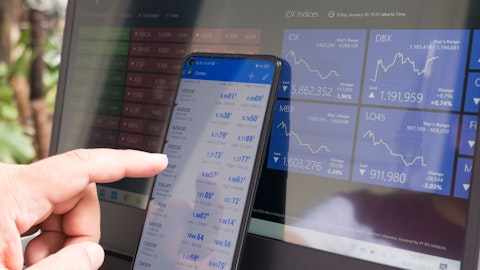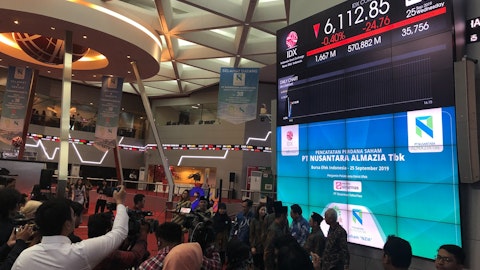As you noted, I’ve increased basically our guidance on fees for management holding at 50. And then also the portfolio, we’ve got $3 billion more coming in there in this rate environment. So yes, we feel better than we did back then just as we learn more, especially with the quality of people that came over, that Kevin referred to in his prepared comments. So strong team, strong results, we feel looking into 2023, which I said, offer tailwinds.
Mike Zaremski: Okay. That’s helpful. And my follow-up on the Casualty and Specialty segment, and I appreciate there’s a lot of different types of business in there. The combined ratio for that segment has been improving, whereas a lot of — some of the primary insurers haven’t seen much improvement in their casualty segments, although I know business mix is different. You mentioned in your prepared remarks about the strength of your casualty, I think, reserves. Then also, I think there were some remarks about some troubled casualty portfolios in the marketplace, which isn’t a surprise. But any more color you want to offer on kind of why you feel really good about your casualty portfolio?
Kevin O’Donnell: Dave, why don’t you take this one? Thanks.
David Marra: Sure. This is David. I’ll start by just saying, as we sort of — casualty and specialty portfolio, there is more than just casualty in it. A big portion of it is specialty and credit, and it’s always a focus of ours to overweight the portfolio towards the most attractive opportunities. And so you saw us grow rapidly in casualty into the market post 2020. And pre-2020, our book was actually quite small. We also avoided a lot of the lines at that time, which were more prone to social inflation like commercial auto. So part of what you’re seeing in the continued strength of the segment, it’s just our active weighting of the different classes. If you now roll on to 2024 with the Validus portfolio, we have an even bigger footprint in specialty classes, which went through a step change in terms and conditions last year, and that’s persisted. So all that comes together in the overall strength of the segment. Thank you.
Operator: The next question comes from Ryan Tunis with Autonomous Research.
Ryan Tunis: First question, just — I guess, it’s just more on just the attritional large losses persona. So I guess we’ve got our spreadsheet that kind of says, yes, European windstorm, as this, Japanese typhoon normally. We’ve got a decent feel for what to expect in terms of REMS market share I’m just curious, is there anything you flagged combining the Validus portfolio, where you think that market share might be a little bit elevated relative to history? And I’m not talking about like the 15100. I’m just talking about more of the quarter-to-quarter attritional large lawsuit.
Kevin O’Donnell: Yes. Let me start here. I think their book looks similar to ours and their book benefited from the step change. So in general, the property cat portfolio is more remote to secondary apparels than it was in 2022. That said, the combination of RenRe and Validus means we’re larger. So I would expect that we will have, particularly on larger losses, a bigger percentage share of participation in the loss. Importantly, we also are growing many of the specialty classes, not only on RenRe’s portfolio, but with the addition of Validus. Some of those are cat exposed. So I think some of the smaller losses that you mentioned, can — we can be a little bit more exposed because of our leveraging into a few of the specialty classes.
I don’t see it as a hugely material shift in being exposed to new losses, but our participation might be a little larger just because our scale is bigger. So when I think about where the portfolio is most exposed, pre-Validus and post-Validus, it’s relatively consistent. I would say, a larger losses, particularly larger peak losses will have a bigger percentage participation just because of our scale. And we might participate more broadly in non-peak territories and perhaps non-peak perils through some of the specialty classes that we write.
Ryan Tunis: Got it. And specialty, I should be thinking more like a man-made type loss?
Kevin O’Donnell: In Marine energy per risk, there is an aviation that kind of stuff.
Ryan Tunis: And then for Bob, I guess just a follow-up on Ian. You mentioned there are some reserve releases there obviously, you put up a big enough initial number, I kind of wanted to check in on — is there still a good amount of IBNR or reserves associated with that event? Or is that pretty much fully seasoned at this point?
Robert Qutub: This is just the annual checkup that we do. In the last week of the third quarter, so it really fell into a fourth quarter review and we got more information, had another year of seasoning. This is the best estimates. But yes, it was far away the largest piece of it. But we go over all the accident year. So we are — we’ll always continue to look at it ongoing and deeper on an annual basis.
Operator: The next question is from Meyer Shields with KBW.
Meyer Shields: Sticking on reserves briefly, if I can. Can we get a sense as to the accident years that were relevant for the Casualty and Specialty segments reserve development?
Robert Qutub: Sorry, let me make sure I got the question here. You’re looking at the relevant years in terms of kind of picking over what David talked about in the years under review by the industry ’18 and prior, going forward relative to 2020 and ’21, I think. In those years, we were — didn’t have a David referred to us having a lighter pin back in there in a smaller presence. We did grow through acquisitions, but with those acquisitions, we got terms and conditions that help protect it. And we actually did some of that protects on our own going back in the pre-’18 years, where we did grow under our pin was in the years that we talked about where the markets got better, which is in 2021, and we actually shape the portfolio for lines that we thought we did well in. So look at what we saw this year, way down in professional lines, and way up in specialty.
Meyer Shields: Okay. No, that’s perfect. Second modeling question. So we have the impact from purchase accounting on the various segments combined ratios. Can we assume that for the near term, if we tweak that up for the fact that there are only two months of Validus ownership, that’s a good run rate in the near term for the purchase accounting adjustments?
Robert Qutub: That’s fair. That’s a fair. It’s going to taper off. Like I tried to say 40% of this is going to be gone by the end of this year. So it will start to taper towards the end of the year.
Operator: The next question comes from Alex Scott with Goldman Sachs.
Alex Scott: I wanted to dig a little bit more into the net versus gross or gross-to-net strategy, I guess, you’re referencing. And on one hand, it’s sort of the way you’re bringing on this Validus book and how much the third-party capital providers are being used? And then also just interested in as you’re going through year-end renewals. In the view that we get to your financials, I guess includes the capital providers, I mean, will there be any noticeable differences on sort of the net to gross retention that we should think about going into 2024 as part of your strategy at year-end?





